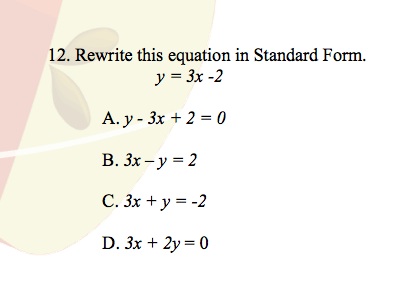

A major part of Algebra I is learning to convert information from equations to graphs and from graphs to equations, and understanding how to analyze equations and graphs as related concepts is a core part of the course. Typically, the first thing students learn how to do in Algebra I is solve a single-variable equation-that is, an equation in which there is only one variable, “x.” Students then learn to graph linear functions in the “y = mx + b” format this part of the course introduces the concepts of slope, y-intercept, and x-intercept, and teaches students to graph linear equations.
#Praxis algebra 1 pro
By establishing solid footing in Algebra I, students can prepare themselves for success in later math and science courses, all of which assume knowledge of algebraic concepts. Whether you need top Algebra 1 tutors in Boston, Algebra 1 tutors in Detroit, or top Algebra 1 tutors in Dallas Fort Worth, working with a pro may take your studies to the next level. Students typically take Algebra I around eighth or ninth grade, though some may take the class earlier or later, after they have had a course in Pre-Algebra, but before attempting such topics as Algebra II, Geometry, or more difficult math classes. Know these, but appreciate that these formulas are far from the whole story of mathematical understanding.Algebra I is a course designed to give students a firm understanding of mathematical equations that involve variables, as well as to teach them the basics of graphing and manipulating simple functions.

Those are the basic Praxis math formulas. P = 1 means an event is certain, guaranteed to happen P = 0 means an event is impossible, guaranteed not to happen In Probability, you should know the expected number formula.Įxpected number of successes = (probability)*(number of trials) I’ll also give you two formulas for slopeĭefinition of mean (average): mean = (sum of terms)/(the number of terms)ĭefinition of range: range = (max value) – (min value) You should understand that m is the slope and b is the y-intercept of the line. In Coordinate Geometry, it’s good to know That’s amount equals work rate times time.ġ liter ≈ 1 quart (a liter is a little bigger) Numbers and Operationsįirst, a few patterns stated in variables: these are not so much “formulas” as patterns to recognize.Ĭommutative Property of Addition: A + B = B + AĬommutative Property of Multiplication: A × B = B × AĪssociative Property of Addition: (A + B) + C = A + (B + C)Īssociative Property of Multiplication: (A × B) × C = A × (B × C)ĭistributive Property: A × (B + C) = AB + ACĪlso, an important fraction pattern, Cross Multiplication: Knowledge of all the formulas is liking knowing all the rules for how the pieces move in chess: yes, that knowledge is essential for play, but mastery of these basic rules is only the beginning-that knowledge alone doesn’t automatically make one a world-class chess master! In this spirit, know these formulas, but recognize how much more there is to learn beyond these. It’s absolutely true that for success in the Praxis Mathematics Test, you should be familiar with some basic formulas in this vein, it’s worthwhile to share these formulas with students.īeware, though: one of the biggest mistakes math students can make is to mistake the knowledge of a formula for genuine mathematical understanding. I will confess, I feel a certain pedagogical ambivalence about offering this list of Praxis math formulas for Praxis Core Math.

# Announcement! As of September 2019, the content of the Praxis Core mathematics test has changed.


 0 kommentar(er)
0 kommentar(er)
